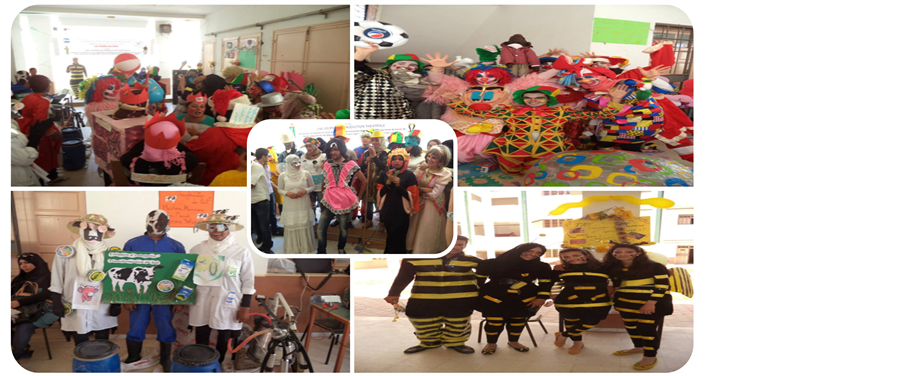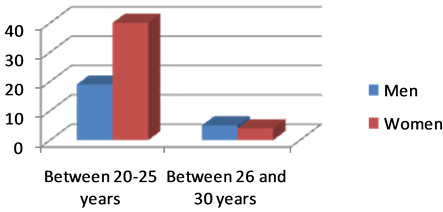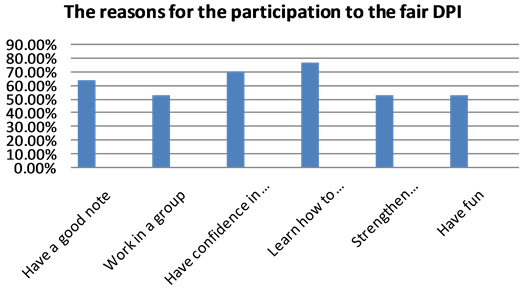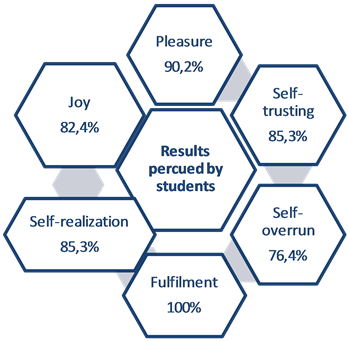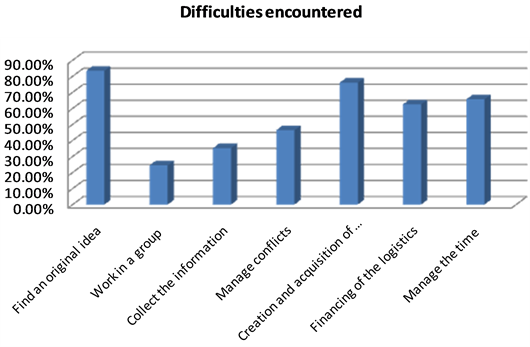Creative Education
Vol.07 No.08(2016), Article ID:67081,9 pages
10.4236/ce.2016.78121
The Learning by the Creation of Event: Theatrical Approach, Interactive, Co-Operative and Individualizing Pedagogy of Project (The Case of the Artistic Carnival of the PPP in the ISET of Gabès)
Sameh Bekri, Inès Drira, Riadh Bouraoui
Higher Institute of Technological Studies of Gabès, Gabès, Tunisia

Copyright © 2016 by authors and Scientific Research Publishing Inc.
This work is licensed under the Creative Commons Attribution International License (CC BY).
http://creativecommons.org/licenses/by/4.0/



Received 5 April 2016; accepted 31 May 2016; published 3 June 2016
ABSTRACT
In the framework of the valorization of the pedagogy of project via the development of the learning by the event, we organized a day dedicated to the fair of the Professional Project personalized by a theatrical production of outputs animated by the students accompanied. This experience based on the adoption of the active pedagogy generated interesting results in terms of satisfaction, self-confidence, positive emotions, exceeding itself, vitality, pleasure and self-realization. An event, which constitutes a clinical case of active pedagogy, worthy of the reinvestments in the future. This document will attempt to synthesize this experience in describing, student the inputs to the catalysis of the participation and by analyzing the main results generated by this event.
Keywords:
Active Pedagogy, Pedagogy of Project, Learning by Creation of Events, Theatrical Approach, Individualizing Pedagogy, Cooperative Learning, Personal and Professional Project

1. Introduction
At the heart of the current concerns of the need to revisit the teaching and the role of its stakeholders, it settles the most of the recasting of the pedagogy toward an active vision where the student is considered as an accompanied responsible actor of his learning.
The passage to an empowering and enabling pedagogy, stimulating the intrinsic motivation of accompanied is required to achieve the objectives of education referred. We are going in a first time draw in the literature to present synthetically. The pedagogy of project and in a second time described the experience of the carnival of the Project Professional custom having taken place at the Higher Institute of Technological Studies of Gabes in June 2015.
2. The Pedagogy of Project and the Learning by the Creation of Event
“To propose another way to teach, more motivating, more varied, more concrete, combine logic of action and programming, such are the ambitions of the pedagogy of the project” (Bordallo & Ginestet, 1993) .
This pedagogy fits in the heart of the current of the new education (Proulx, 2004; Ben Salem, 2010; Reverdy, 2013) where the members, including Delcroy, Dewey, Freinet, Montessori, have tried since the beginning of the xxth century to experiment and theorize practices under this pedagogical approach active (Proulx, 2004) .
According to Proulx (2004) , Kilpatrick in 1921 “advocated a pedagogy centerd on learners, on their goals and on their needs. From there, it was necessary to develop for them useful activities, oriented toward concrete goals and making use of the skills to solve problems.
The project approach as the other methods say “active” takes in effect its source in the United States where Dewey (1912) launches the method “learning by doing”, which is to learn by and in the action (Proulx, 2004; Riverdy, 2013) .
Active pedagogy aims to make the learner actor of its programming, in order to build its knowledge through situations of research (Perrenoud, 2002; Amégan, 2010; Michonnaud, 1999) .
Freinet, one of the pioneers in active method, is particularly concerned with creating in his school, he wants that learners create; it advocated a pedagogy which concrete either […] which would leave the Learner to its experiences […]. For him, it is the teacher who organizes the learning context, which guide the learner in its approach to trials and errors and which reinforces the appropriate and desired behaviors (Proulx, 2004) .
The learning by the creation of event fits in the heart of the pedagogy of project1: the accompanied will be mobilized, accountable in any freedom to participate in the creation of an event. This mode of learning will allow him in particular to learn to work in a team to be autonomous, to seek to synthesize the information, to acquire professional experience in the conduct of project, to develop knowledge and to accomplish personally taking more self-confidence, drawing in creativity, in managing the stress and the emotions and facilitating effective interpersonal relations (Leclercq & Poumay, 2008; Hubert, 1999, Hullen 1999) .
The creation of theatrical event is the educational experience of project that we would like to publish as a research action. There we are looking primarily to help each student to take self-confidence, strengthen the personal and collective identity through a form of empowerment, taking a power of actor, develop the cooperation and collective intelligence (Perrenoud, 1998) and to help forge a new track of learning by the artistic teaching.
3. The Experience of the Theatrical Carnival of the Professional and Personal Project at the ISET of Gabes
3.1. Brief Overview on the Project Professional and Personal Module
The Professional and Personal Project is communicated to the students of the license applied in the administration of the affairs of the Economic and management Science of Department of Gabes since February 2008.
This module has the objective to accompany the student in the construction of its project staff and professional. To achieve this, three axs distributed on three semesters are the subject of the Accompaniment: an axis of job knowledge (J.K.), an axis of self-knowledge (S.K) and an axis of Job Search Techniques (J.S.T.).
In this perspective, the student is the actor of his project juggling between professional sphere and that personal (Perrenoud, 2001) . It is accompanied by a guardian who the Oriente and the advises in the outline of its project by borrowing an interactive pedagogy based on the accountability of accompanied via their mobilizations and their motivations essentially intrinsic (IUT, 2008).
Since the integration of the ppp module within the ISET of Gabes, a culture of dynamization, accountability, mobilization has begun to develop. The facilitator of the module is past from a state of teacher to that of attendant who directs, communicates, coachs the accompanied.
The results in terms of involvement of the students and their satisfaction have been quickly observed and amply communicated by the accompanied that have mobilizied their desire and initiative to create a space PPP which is reserved for them.
3.2. Presentation of the Experience of the Theater Fair
In the framework of the valorisation of accompanied’s outputs in PPP, we2 organized the event of a carnival fair of PPP via a theatrical production animated by the students of the Department of Economic and Management Sciences.
1) We have asked the students to choose a character PPP that they draw in the pins of the module: this character can be a profession (J.K), an attitude(SK), a project or a track Personal or Professional (JST): the student would choose the element that motivates the most and who will mobilize the most in the active participation in this event. This phase is the most delicate, because the idea of such a project should be original, attractive, relevant and especially feasible.
2) The student is called to work in a team, and for this it must be divided into homogeneous group according to the theme or the axis of PPP chosen. Here our objective as an attendant is to enhance the cooperative work, accountability and to assert the learning by the individualization, the collaboration and the sharing.
The groups thus constructed are called:
・ To define the characters, to imagine, design, create, or acquire the most appropriate costumes to the roles to play.
・ To script the piece of theater to put in scene.
・ To make an inventory of the elements required for the realization of their parts.
・ To share their resources (financial, human, physical).
・ To divide with effectiveness and efficiency the tasks.
We through these instructions referred to:
・ Develop interactive learning of the student who is responsible individually and collectively to the success of its project.
・ Valuing the creativity and ingenuity of the accompanied.
・ Empower individually and collectively the accompanied.
・ Develop interpersonal communication amongst students.
3) Students are then called:
・ To do briefings.
・ To describe their scenarios.
・ To present to all stakeholders of this fair, the exhibit to play, as a test.
・ To organize the day of the fair: music, scene, accessories…
The goal through all this experience is mainly to enhance the openness of spirit, openness to experience, to mobilize the students, empower, develop their background communicational, to solicit the management of their emotions and the emotions of the other, stress and develop the confidence in itself.
The objective is also to boost the department via a pedagogical innovation and to establish a friendly atmos- phere inviting the emotional explosion3 and talents of both attendants and accompanied.
3.3. Description of the Preparation Phase of the Event
3.3.1. Attitude of the Accompanied Upstream, during the Presentation of the Project
During the first presentation of the event to the accompanied, we noticed a great reluctance, and an apeurement participation in a project not usual. We have, to this effect questioned 68 students who were we explained the event and the individual contribution of each, on the potentiality of their holdings and on the reasons for such an attitude.
Only 4 students, either 6.35% are motivated and volunteers, all other have refused to participate:
・ By lack of self-confidence (idea not original, afraid to present and to express themselves in front of all the students of the Institute) (33.4%).
・ Because they have not learned to do it (17%).
・ Because they did not see the realization of the project (35.6%).
・ Because they perceived the theater as “non-ethics” (5%).
・ Because the theater does not fall within their area of competence (9%).
3.3.2. Call to Coercion and Self-Confidence
Before this finding which was fairly predictable, we have decided to appeal to empowering and individualising communications in the goal to develop self-confidence and to be openend on new experiences!4
We have also appealed to the coercion in specifying that any person who will volunteer and active in this experience will have a minimum score of 16/20 to the appreciation of the practical work, against a heavy made to note severely for those who will not partcipate in the project.
Certainly, this coercion is an extrinsic motivation which deviates from the objectives mentioned above of the pedagogical approach that we were trying to develop via this theatrical fair, but the reluctance was much strong (either 93.65% of the students who have refused at the outset to participate in this Fair). This coercition is also based on a experiential background arguing in favor of the attraction of students by the note. So, we have chosen, for a first experience, to inject this coercive input to generate a participatory action (Giddens, 1987; Scott, 1995) .
We referred to “phish “accompanied by this computational, instrumentalist ground (Dameron, 2004) in this original experience and we will drop it in the future experiences, when the results of the development would be achieved by the past, forging cognitive deposits in favor of the action generation ( Feldman 2000; Zucker, 1987 …).
3.3.3. Active Participation and Deliberate Cooperation
The input described previously constituted a pattern to the action of the accompanied: we observed motivated students, cooperative, creative, responsible, rigorous, merry… We promise to “self-challenge, to defy the other and especially not to disappoint the attendants who are given a lot of sentence to push us to succeed and to prove to the whole world that we are at the height of any constructive objective”.5
We observed students who are hitched to work outside of their sessions and even after the Hours of Labor, who consulted constantly the attendants on the smallest details: costumes, makeup, music, speech, stakeholders…
Some volunteered for the makeup and are distributed according to their areas of excellence (clowns, trades, state of self-knowledge…), other for drawings and graphs, others for the creation of costumes and even for their seams…
3.4. Description of the Attitude of Students during the Fair of PPP
On 04 June 2015, at 6 h of the morning the students were present, dynamic and highly motivated: Each group is divided into well specified tasks: as shown on Figure 1. Behind the scenes we observed responsible and very creative men having ingenuity which far exceeded our expectations. We have noticed the emotional intelligence, effective communication, the cooperative and very well organized, performed and efficient work.
A feeling of pride was immediately clear of attendants who are preparing to implement an educational innovation in the education institution to which they belong and which is desired is also a personal challenge and community rely on the students.
A 9 H, the scene was there, the accompanied disguised and masked with much rigor, held and eccentric make- up showing the protrusion of the shyness and revealing the attitudinal explosion (which has been mentioned previously).
They even have creative were collectively by creating the booths where they have exposed via posters their ideas and the direct relationship with the ppp module and the related axis.
They also took the initiative to invite students outside their Institute, as well as those of other departments and they appealed to students to deal with the music and animate the day.
Figure 1. Exemples of student’s outputs in PPP fair (April, 2015).
They have made the initiative to present the da/nce of the PPP which brings together all students PPP and to verbally communicate their satisfaction in respect of the experience.
We have seen the realization of their ideas in a good mood and usability.
3.5. Investigation on Students Deferred Attitude about the PPP Carnival Experience
3.5.1. Presentation of the Survey
As facilitators PPP having catalyzed, as far as may be possible, the experience of the fair via the theatrical pro- duction, we found convenient to assess the attitude of students in respect of the project that they have mate- rialized, to study the explanatory factors. We have thus investigated via a survey of 68 students either 100% of the population who participated as a direct Players to the theatrical production.
The demographic characteristics of the surveyed sample are as followed in Table 1.
In addition, concerning the age of respondents, as presented in Figure 2, the majority of respondents either 86.7% are placed in the age group ranging from 20 to 25 years.
The axs of the survey revolve essentially around the following elements:
・ The degree of satisfaction with this experience.
・ The objectives covered by the accompanied before the day.
・ The degree of achievement of the objectives.
・ The reasons for the action (Herring, 2012) 6 of participation to the event: the note, the mimicry, achievement of a collective project, have fun, auto accomplishment, distrust.
・ The emotions generated by this experience.
・ The predisposition to repeat this experience.
・ The results of the experience in terms of self-realization, vitality, exceeding the self, self-confidence.
・ The difficulties encountered.
・ The prospects for improvement.
3.5.2. The Main Results of the Investigation
Reasons for participation in the event of the fair of the DPI
the investigation has enabled us to detect that the reason which has pushed the more the accompanied to act, is to be able to collectively submit (76.7%), to have confidence in itself (70%), to have a good mark (67.6%). 52.9% are intended the fun because they think that their institution does not offer a framework for the entertain- ment and this opportunity is therefore an opportunity.
Figure 3 shows that all grounds have aroused the active participation of more than 50% of the accom- panied.
Figure 2. The distribution of respondents by age.
Table 1. The distribution of respondents according to the type.
Achievement of Objectives
93.9% of the students found that this experience has enabled them to achieve strongly the objectives they have set in participating in this experience.
Satisfaction and emotions generated by the experience
All respondents (100%) are satisfied by this experience. 66% are very satisfied.
As shown in the Figure 4, the experience was at the origin of the satisfaction, of the joy and optimism in more than 90% of cases.
This experience despite the reluctance that it has caused to the beginnings is a great succedto its achievement. The deferred attitude does’nt influenced the positive image that participants have kept of the experience.
The results collected by the accompanied
The experience of participation in the fair of the PPP has made personal and collective targets beyond our expectations. In fact, and as well as it is presented in Figure 5, all the students who participated in this ex- perience flourished (100%) 90.2% have had the pleasure to cooperate with this event.85.3% of the respondents have argued that they are selfrealised by this experience which has enabled them to have a self-confidence. Many are those who have explained their satisfaction by the challenge of this project succeed which generated an self overrun in 76.4% of cases.
Intention to repeat this experience to the future
92.5% of respondents argue that they are predisposed to repeat this experience. This intentional attitude is explained by the positive results of the experience and by the overall satisfaction regard (100%).
This result surprises us positively compared to the attitude of reluctance at the begining of experience when 6.35% only were volunteers in the realization of the fair project. This allows us to describe this first carnival as a success to improve and to revisit.
Difficulties encountered
Many difficulties have been communicated by the accompanied at each phase of the realization of the event. The facilitators have chosen not to intervene in the first phases to push the accompanied deploy its means and its resources which the will involve more in the implementation of the project in question. When a lock which requires the intervention of attendants is observed, we turn to the resolution of problems in leaving the attendant to develop solutions and ensure the feed-back. This attitude has been adopted to empower and involve more the accompanied.
Figure 6 presents the main difficulties encountered revolve around.
The search for an original idea which can clearly reveal the axis of the PPP to represent via the theater piece chosen: this result (83.4%) is expected because we have lived in the vicinity of this difficulty and it is this step that took the most time by the accompanied:
Figure 3. The reasons for the participation of accompanied to the event of the PPP Fair.
Figure 4. Attitude and emotions generated by the experience.
Figure 5. The results collected by the accompanied.
・ The creation and acquisition of costumes (76%), in fact, the students had difficulty finding a the idea of costume and the way to accommodate.
・ The financing of the logistics deployed on the day of the Fair (62.5%).
・ The time management (65.6%).
Despite these difficulties, the accompanied have demonstrated a high interactivity and effectiveness/with a lot of intelligence, they have managed to overcome the constraints and to perform in the success of this experience that is the fair PPP.
4. Conclusion and Prospects
The Fair of the PPP via a theatrical production animated by the students was taken place on the High Institue of
Figure 6. Difficulties encountered.
Technological Studies of Gabes, on 04 June 2015, was an experience which served as a clinical case showing the scope of the pedagogy by project on the satisfaction, emotions, the motivation of the students. It is an approach which relies on the interactivity, accountability, the management of emotions, the individualizing accompaniment and whose results are overall very positive to create the framework for the teaching a space of vitality, joy, pleasure, surpassing oneself, decision of self-confidence and self-realization… Sources of intrinsic motivation of students: experience to enhance, to revisit and to try strongly to any institution which investts on pedagogical innovation and on its students!
It is true: the toltecs approach is a new vision based on emotional intelligence and theater to valorise the pleasure of students and their spiritual development.
In this pedagogical lineage, we aim to make this experience an annual event ritual that constitutes the crown of the completion of the three modules of the PPP.
A brainstorming session to refer for improvement of this experience had been carried out at the beginning of the academic year 2015-2016. It has led to the proposal of an art fair which would no longer be limited to the single pane theatrical, but which would open at all the arts!
This need, strongly felt by the accompanied, has pushed us to draw in the literature to feed this embryonic experience by the integration of the other living arts including dance, painting, poetry…
In fact, the proposal of the students is very exciting because it allow us to paddle along the track adopted and to explore new artistic furrows develop further the different talents of students, by the way to melt with the objectives of the PPP in terms of individualisation and of the potential management of the proximity.
The Toltec track (Ruiz, 1999; Maggio, 2013) , therefore, is the way that we will adopt.7 By doing this, a Toltec accompaniment be strongly recommended essentially in the module of self-knowledge.
For the putting in value of the Toltec mosaic, we propose to evolve the theatrical fair to a Toltec Day Carnival of the PPP… The feed-back in experiential be recommended!
Cite this paper
Sameh Bekri,Inès Drira,Riadh Bouraoui, (2016) The Learning by the Creation of Event: Theatrical Approach, Interactive, Co-Operative and Individualizing Pedagogy of Project (The Case of the Artistic Carnival of the PPP in the ISET of Gabès). Creative Education,07,1166-1174. doi: 10.4236/ce.2016.78121
References
- 1. Amégan, S. (2010). For an Active Pedagogy and Creative. 2th Edition, Presses of the University of Quebec, Quebec, 42.
- 2. Ben Salem, D. (2010) What the Pedagogy of Project Allows It to Give Meaning to the Teaching of French? Synergies Algeria, 9, 75-82.
- 3. Bordallo, I., & Ginestet, J.-P. (1993) For a Pedagogy of the Project (p. 132). Paris: Hachette Education.
- 4. Dameron, S. (2004). Expediency or Need of Belonging? The Duality Co-Operative in the Case of Project Teams. Official Journal of the International Association of Strategic Management, 7, 137-160.
- 5. %Feldman, M. S. (2000). Organizational Routines as a Source of Continuous Change. Organization Science, 11, 611-629.
- 6. Giddens, A. (1987). The Constitution of the Company. Paris: PUF.
- 7. Herring, L. (2012). The Moral Value of the Grounds of the Action: Motivation Ethics and Reasons (pp. 143-146, 5nd Ed.). Oxford: Medical Law and Ethics.
- 8. Hubert, M. (1999). Learn in Projects: The Pedagogy of the Project-Students. Lyon: Chronic Social.
- 9. Hullen, J. (1999). Seminar Pedagogy of Project. TECFA.
- 10. Leclercq, D., & Poumay, M. (2008).The Model of Events of Learning/Teaching. LabSET-IFRES-ULg.
- 11. MAGGIO, F. (2013). The Coach Toltec-In the Gold Book of Caoching. In F. Bournois, & T. Chavel (Eds.), GEODIF. Paris: Eyrolles.
- 12. Michonneau, B. (1999). Treatment of Texts and Pedagogy of the Project: A Successful Marriage. The Bulletin of the PPE,
http://www.uis.unesco.org/glossary/index.aspx?lang=fr - 13. Perrenoud, P. (2002). Learn at School through Projects: Why? How? Educator, 14, 6-11.
- 14. Perrenoud, P. (2001). The Project Staff of the Student, a Fiction (p. 21)? Geneva: University of Geneva, Laboratory LIFE. http://www.unige.ch/fapse/SSE/teachers/perrenoud/php_main/php_2001/2001_20.html
- 15. Perrenoud, P. (1998). Succeed or Understand? The Classical Dilemmas of an Approach of Project. Geneva: University of Geneva.
http://www.unige.ch/fapse/SSE/teachers/perrenoud/php_main/php_1998/1998_39.html - 16. Proulx, J. (2004). Learning by Project, PUQ.
- 17. Reverdy, C. (2005). Projects to Better Learn? Folder of Standby News and Analyzes, No. 82. http://ife.enslyon.fr/vst/DA/detailsDossier.php?parent=accueil&dossier=82&lang=fr
- 18. Ruiz, D. M. (1999). The Four Agreements Toltecs. Paris: éditions Jouvence
- 19. Scott, W. R. (1995). Institutions and Organizations. Thousand Oaks: Sage Publications.
- 20. Service Pedagogical Unit (2011). The Guide of the Mentee Project, University Paul Sabatier Toulouse.
- 21. Zucker, L. G. (1987). Institutional Theories of Organization. Annual Review of Sociology, 13, 443-464.
NOTES
1 Service Pedagogical Unit (2011) : the guide of the Mentee Project, University Paul Sabatier Toulouse.
2The cell of the Project Professional custom of the Department of Economic Science and Management of the Higher Institute of Techn- ological Studies of Gabes.
3“The explosion” is a term that I used to shock, and arouse the interest of the accompanied to release everything he has as a human potential to generate.
4The students are accompanied since three semesters and with the individualizing vision the PPP, we have learned to know and to predict their attitudes in the face of the changes.
3 The representative of students took the floor in the amphi to interact with the attendant who communicated its worries (April, 2015).
6Laurence Herring, the moral value of the grounds of the action: ethical motivation and reasons, Edition Harmattan, France, February 2012, pp 143-146.
7According to Ruiz (1999) Toltec, wants to say artist. Maggio (2013) presents the coaching Toltec-as a fundamental way of self knowledge and the collective coaching.


